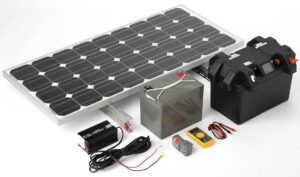For all technology and gadget lovers – the majority of those reading this I’d assume – one thing is considered critical, a steady and reliable source of electricity to keep those circuits crunching numbers and to keep those drives and fans spinning happily.
Whilst most of us take a reliable and steady supply of electricity for granted, we are now reaching the dreaded time of the year where the national energy provider, Eskom, has a different set of plans. The plans Eskom has are unfortunately all too familiar; to decrease and stabilize the national demand for electricity by means of rolling blackouts operating on a schedule throughout the country, otherwise known as load shedding.

In a press conference earlier this week the Eskom CEO announced that Eskom predicts a 2,000 MW (Megawatts) daily shortfall in electricity supply for the entire winter of 2013, and has admitted that load shedding may be “unavoidable”. For the sake of context, 2,000 MW works out to more than the total production capacity of Koeberg, South Africa’s nuclear power plant or roughly a quarter of a million South African homes – and that is a conservative estimate. With this in mind, it is highly likely that some form of load shedding or another will take place in the coming winter months. Whether it be the scheduled rolling blackouts South Africans were introduced to in 2008 or more random, unforeseen outages.
The technologically inclined reader will be wondering what you can do to minimise the disruption to your daily schedule, besides reverting to candles, heaters and fires for light and warmth. There are ways to safeguard your home’s, if not at least a few of your devices, power supply during load shedding.
First and foremost of these is to be able to generate your own electricity with a petrol or diesel powered generator.
Alternatively one can make use of your own stored electricity, even if it’s only enough to power a small area of your home. This is done by means of a battery bank, which can either be charged via a solar panel, wind turbine or can be charged from the mains when the electrical supply returns.

If you plan on using a backup source of power, the chances are that you will need to get yourself an electronic box called an inverter. An inverter is an essential component to any electrical back-up, whether it be a solar installation, wind farm, or battery bank – they all need an inverter to change the type of electricity from DC to AC before sending it on to power one of your devices. One must be careful before buying an inverter as not all inverters are created equal. Some high-output models can successfully provide enough power to light up your entire house, however, this would require an unfeasible number of batteries, solar panels or wind turbines for the average individual to be able to afford. A much more affordable solution would be to power a specific area of your home using an extension cable or small multi-plug, such as the TV room, lounge or study.
The type of inverter best suited to coping with load shedding is known as a stand-alone inverter. Stand-alone inverters, as the name suggests, are not connected to the mains electricity, rather these inverters draw their electricity from batteries that have been charged either by photovoltaic solar panels, or by small wind turbines. Once the mains power has been restored, the solar panels or wind turbine then recharge the batteries, in preparation for the next outage.
A small standalone inverter attached to a bank of two or three 12v batteries should be able to run a medium sized LED

TV, and a Set Top Box for DSTV, MNet or TopTV for around 3 hours, roughly as long as each bout of load shedding. The same inverter could also be used to power a laptop computer (Desktops are much less energy efficient) for an a fair amount of time, roughly 4 hours before the inverters battery runs out of charge and the laptop’s own battery takes over, provided the laptop is set to the most energy efficient setting. Using an Ultrabook will also improve the amount of time the battery bank can provide power due to the improved energy efficiency offered by Ultrabooks.
Inverters can also be used to power lights, heaters, garage and gate motors or you home security system. It however important to note that incandescent light bulbs are extremely wasteful in terms of the amount of electricity used to produce light, with a huge amount of energy being wasted in the form of heat. It is recommended that all individuals and businesses (regardless of whether they are in South Africa or not) change all the light bulbs in their home or workplace to Compact Fluorescent Lamps (CFLs). CFLs dramatically decrease one’s energy consumption and last a far longer than their outdated incandescent counterparts.
If South Africans work together and everybody contributed by doing their part as envisioned by Eskom’s 49M initiative load shedding can be avoided if not somewhat minimized, but only if the country’s winter electricity usage falls by 10% compared to last year’s levels (a massive task by anyone’s standards). This would stabilize the country’s electrical demand and enable everyone to be supplied with energy. However, decreasing electrical demand by 10% will require much more than simply swapping out inefficient light bulbs, but these small actions are a step in the right direction.
Overall, preparation and forethought are the best ways to minimise the disruptions that can caused by load shedding. Simple actions such as ensuring the geyser is only switched on during times of low demand, such as the middle of the day, and that all non-essential appliances are switched off and unplugged where possible before the peak demand times of 06:00AM to 10:ooAM and 5PM to 9PM when done by many individuals add up to a large and noticeable difference.








